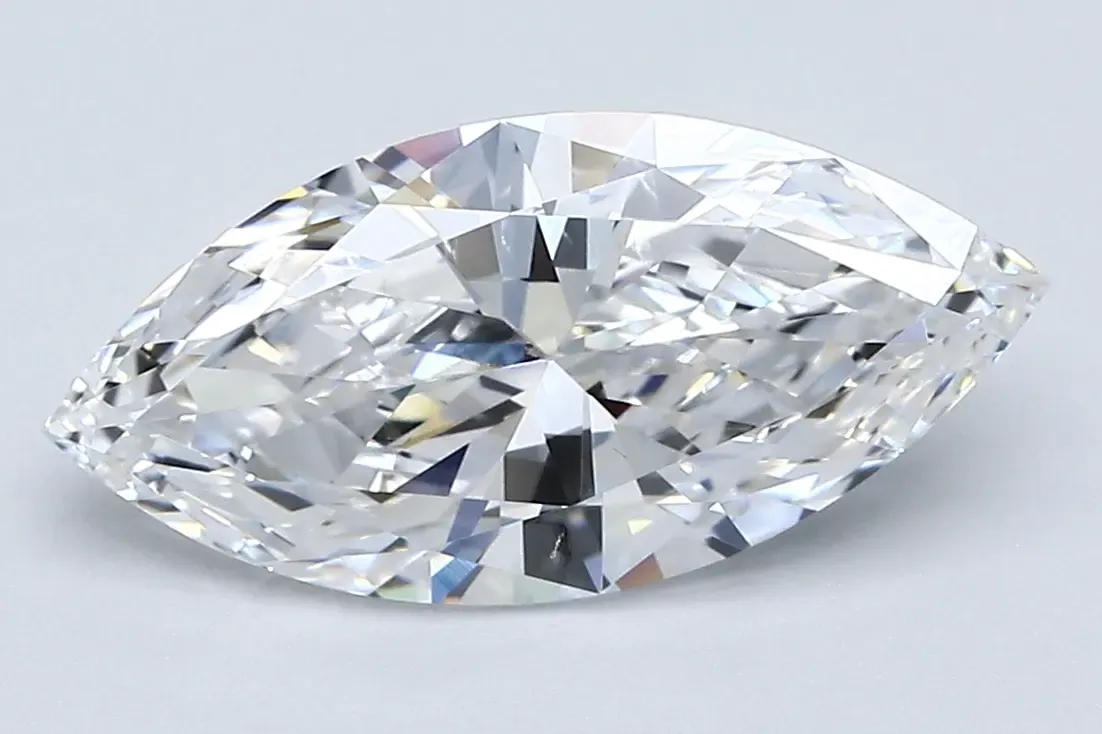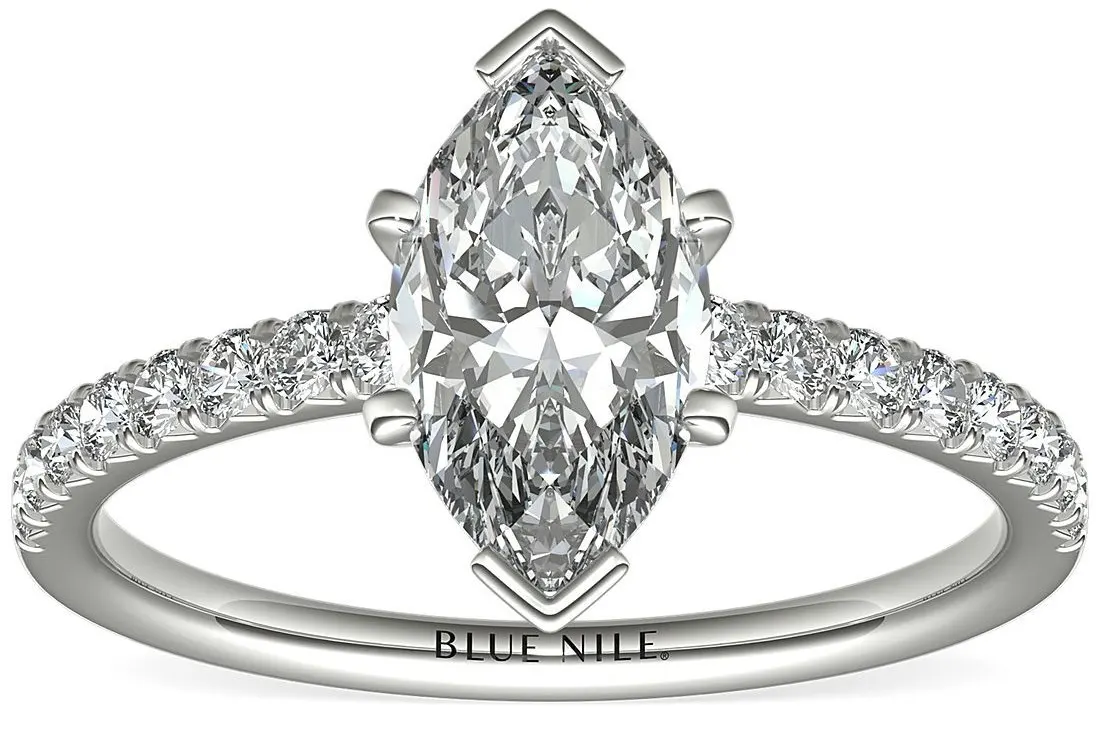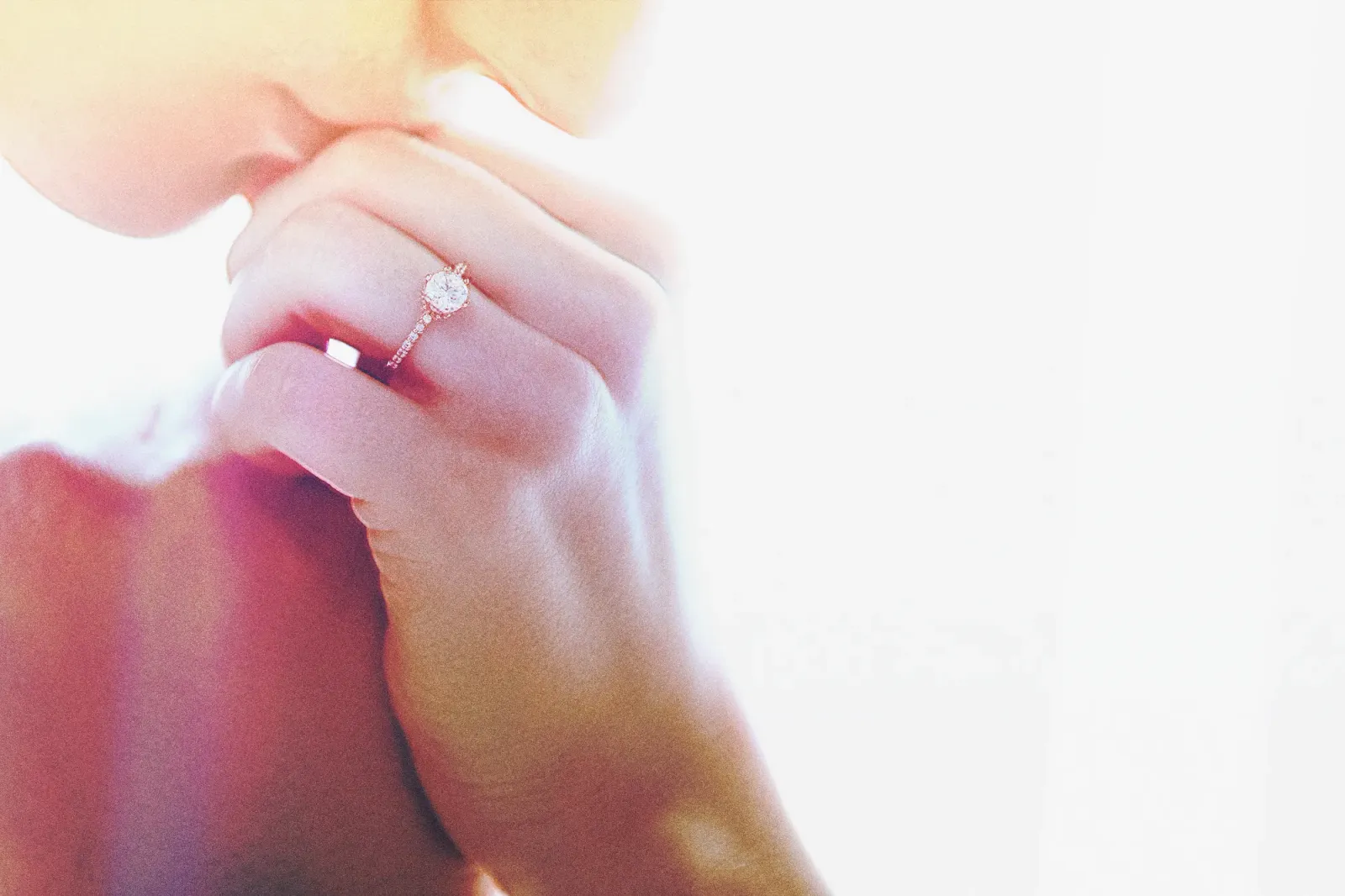Marquise cut diamonds are strikingly beautiful. With an elegant curve from point to point, the appeal of the marquise lies in its distinctive style. This unique shape means there are key things to look for when buying, to ensure you're getting the best for your money. Its brilliant cut sparkles beautifully whilst the elongated shape gives the impression of a larger carat weight. A 1 carat marquise is often over 1cm (0.4") long, whilst a 1 carat round has a diameter of about 6.5mm (0.26").
Steeped in history, it's said that this cut was developed for Louix XV of France, to resemble the lips of his mistress the Marquise de Pompadour (Madame de Pompadour was one of the most powerful women in 18th century France). And if that cheeky little story's not to your taste, the marquise cut is also known as the 'navette' when applied to other gemstones, old French for little ship.
The resemblance to a petal or leaf means you will also see marquise diamonds in nature inspired jewelry designs, with smaller diamonds making up floral shapes.

Marquise diamonds: find the best shape
Whist there are some technical aspects to purchasing a marquise diamond, it's just as important to find one with a shape you like. Some are cut long and narrow, while others are cut shorter and wider. Shape is in part determined by the length-width ratio of the diamond, and in part by how the cutter has shaped the belly, wings and points of the marquise.

Look for a diamond with an elegant outline and well defined points. The images below show the effect of bulging wings and poorly cut points. When the wings are cut with a bulge, or too flat, it affects the appeal of the diamond so it's important to evaluate the diamond as a whole as well as checking each area.



The first marquise diamond has an elegant outline whilst the second has bulging wings. The tips on the third diamond are so ill-defined it looks like a poorly cut oval.
The symmetry of a marquise is also an important component of a beautiful shape. If you draw an imaginary line down the center, you can check if the tips are aligned and if the belly and wings are symmetrical. Then draw a line across the belly and do the same. Take a look at this diamond from James Allen carefully, and you'll see that the outline of the belly and wings is subtly different on each side. And looking at this diamond from Blue Nile the tips are very different shapes - almost like the ends of two different diamonds! This is where the high quality videos and imagery on sites like James Allen and Blue Nile are your friend, giving so much more information than the certificate and description. Please also note that the symmetry grade on a certificate only assesses facet symmetry not symmetry of shape.
Marquise diamonds: length to width ratio
As with oval diamonds, marquise diamonds are cut to different length to width ratios, meaning you're sure to find an outline that you love. Calculated by dividing the diamond's length by its width, the most popular length to width ratios for a marquise diamond are bracketed around the 2:1 mark, usually ranging between 1.7:1 t0 2.2:1. You can see the differences in shape in the diagram below.

If you like the look a certain ratio gives, the Blue Nile website allows you to filter by length to width ratio, unlike others. There is no 'ideal' marquise diamond shape, so whether shorter, longer or somewhere in between have the confidence to follow your heart.
Marquise diamonds: the bow-tie effect
Whilst a bow tie will be worn with pride to a black tie event, it's a look to avoid if you want a diamond with maximum sparkle. The faceting pattern of this elongated shape means that you'll find a dark pattern across the middle, known as a bow tie. They can be near invisible, but a severe bow tie will dominate the diamond and significantly detract from its beauty.



These marquise diamonds all show the bow-tie effect to varying degrees.
When looking at marquise diamonds online it's vital to make the most of the 360° videos, not just the photos, to see the extent of any bow tie. Play with the video for this diamond from James Allen, and you'll see how the bow tie is visible from multiple angles, whereas the light and contrast is distributed evenly through this diamond from Blue Nile.
Marquise diamonds: cut quality
Here at The Diamond Handbook, when we talk about the 4Cs of diamonds - cut, clarity, color and carat - we always bang the drum for cut quality having the greatest affect on the beauty of a diamond. This is because it has the greatest impact on how light travels through the diamond for sparkle and liveliness. But it can be tricky to evaluate the quality of a marquise cut because there are no specific proportions for an 'ideal' marquise. It's only the round brilliant that the GIA will grade for cut; there are too many variations in the marquise for a specific 'ideal' to be nailed down.
However, experience tells us that whilst there is no list of 'ideal' proportions, there are broad proportions that will sort the best from the bad.
| Marquise Cut | |
|---|---|
| Table % | 54% - 63% is excellent, or up to a percentage point either side is very good. |
| Depth % | 58% - 64% is excellent, or within two percentage points above or below is very good. |
| Length to Width Ratio | 1.7 - 2.2 for a pleasing shape. |
| Girdle | Thin - Slightly Thick |
| Culet | None - Very Small |
Marquise diamonds: clarity
As with all diamond shapes, buying what's called an 'eye-clean' diamond presents the best value. These are diamonds where flaws are not visible to the naked eye. And because the marquise diamond is a brilliant cut, the light return and sparkle of a well cut marquise is pretty good at hiding flaws.
The GIA grades diamonds from Included, right through to Flawless, and we've written about the various grades and how they are assigned here. The most important thing to note is that grading takes place under 10x magnification, therefore even when flaws are noted on a certificate they may well be invisible to the naked eye.

For a great value eye-clean marquise diamond, we recommend sticking to a clarity of VS2 or SI1. That said, it's still important to look at each diamond closely with the high res videos, so that you can see the position and size of each flaw for yourself. The certificate grade alone will not tell you everything you need to know. Contrast this VS2 diamond where the flaws are distributed around the edges of the diamond with this VS2 diamond with flaws concentrated on the table. Also, flaws can be more visible in larger diamonds, so you may need to nudge up the clarity grades as you go above 1.5 carats.
Eye-clean diamonds will definitely offer the best value, but if you prefer a more technically clean diamond VVS and VSI diamonds have fewer flaws. To a greater or lesser degree, even when invisible, flaws and inclusions affect how light passes through the diamond. Therefore the higher clarity grades are sought after by those looking for a more technically clear diamond (hence the higher price tags).
Marquise diamonds: color
In elongated shapes such as the marquise or oval cut, a diamond's color will seem to be more concentrated at the tips compared to the center. It's a pretty extreme example, but the marquise diamond below is a J color, and the belly of the diamond looks far whiter than the ends.

For this reason, if you're after that clear icy look, you need to stick to a G color or better. Larger diamonds show color more, so for a marquise over 1.5 carats stick to the 'colorless' grades, with an F or above.
As with any diamond shape, take into account the metal that you're choosing for your setting. The warmth of a yellow or rose gold setting will make diamonds with color appear whiter. Equally, ensure you set a colorless diamond in white gold or platinum to avoid warm golden light reflecting into an otherwise colorless stone.

This 18k yellow gold 'Laurel Leaves' setting celebrates the shape of the marquise, as well as giving plenty of sparkle.
Marquise diamonds: pricing
Carat for carat, and all else being equal, marquise diamonds tend to be cheaper than round brilliant diamonds. This is in part because there is less wastage in the cutting process as the long shape makes better use of the rough. Fancy shapes are also cheaper than round brilliant diamonds due to being less popular, so normal market forces mean a slightly lower price for a diamond shape with less demand (round brilliants account for three quarters of all diamonds sold).
And don't forget the elongated shape of a marquise gives the visual effect of a larger diamond, with a 1 carat marquise often measuring over 1cm tip to tip.
Marquise diamonds: choosing a setting
The marquise offers a graceful yet bold shape. They can be set in many different styles, and you'll notice that all good settings protect the vulnerable tips. This classic knife edge setting distributes six prongs around the diamond, whilst the pavé setting below uses a v-shaped prong to protect the tips.

A marquise diamond can offer a twist on a classic, like this pavé diamond ring in white gold.
Despite being one of the more uncommon fancy diamond shapes in engagement rings, it is incredibly versatile. Suiting modern, fashion forward looks as well as classic or vintage inspired designs, the marquise diamond can also be set east-west for a more unusual look.

This east-west setting offers an even less conventional setting, still making the most of the elongated shape of the marquise.
And if you like the elongated look of the marquise but want to consider alternatives, you can read up on oval diamonds here, or pear shaped diamonds here.




